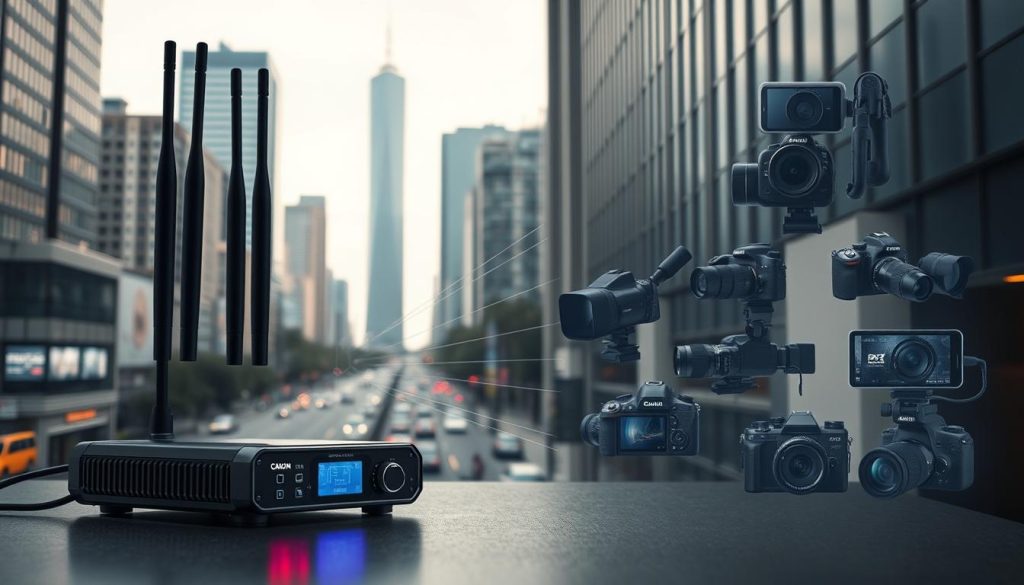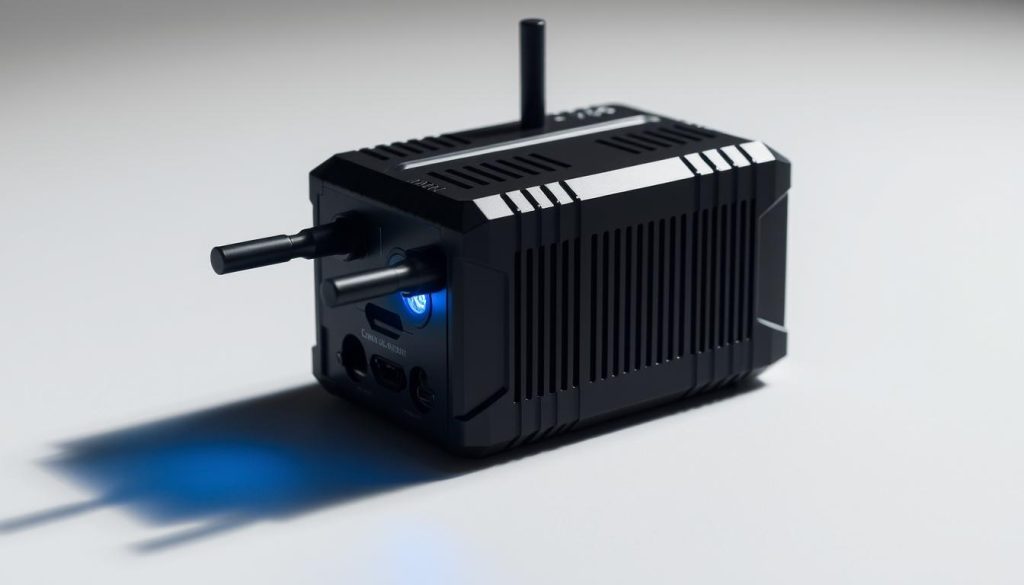A camera jammer is a device made to mess with video surveillance systems. It does this by blocking the signals that cameras use. This is done by using different frequencies to stop wireless signals, so no footage can be recorded.
Because it can target specific camera frequencies, a camera jammer is great for keeping your privacy. It works well in both public and private areas. This makes it a useful tool for anyone wanting more privacy.
Key Takeaways
- A camera jammer disrupts signals to prevent video recording.
- It employs specific frequencies targeting security cameras.
- This technology is increasingly utilized for privacy protection.
- Camera jammers play a role in surveillance disruption.
- Understanding how these devices work is key for using them wisely.
Understanding Camera Jammers
Camera jammers are key tools that block unwanted surveillance, protecting our privacy. In today’s world, where surveillance is common, their role is vital. They work by jamming the signals from cameras, stopping them from recording or sending images.
It’s important to know about the different types of camera jammers and how they work. Each type has its own strengths and weaknesses, depending on the surveillance system it targets. Learning about these devices helps us keep our privacy safe. Knowing how camera jammers work gives us a better understanding of their impact.
Understanding camera jammers helps us stay safe and know our rights in a world with growing surveillance. It’s a way to fight back against unwanted monitoring.
How Camera Jammers Work
Camera jammers send out signals that disrupt the frequencies used by surveillance cameras. Their main aim is to stop cameras from working right. They use interference technology to fill areas with signals that block cameras.
These devices often use microwave pulses to affect many camera types. The jammer’s power and the camera’s technology decide how well it works. Sometimes, cameras just get a little wonky, other times they stop working altogether.
By blocking surveillance, jammers help people keep their privacy. Knowing how functionality of camera jammers works is key for those who want to protect their privacy.
What is a camera jammer?
A camera jammer is key in keeping your privacy safe by blocking unwanted surveillance. Knowing how camera jammers work helps people make smart choices about using them.
Definition and Functionality
Camera jammers block signals from video monitoring systems. They stop unauthorized access to visual recordings. You can find them in portable or handheld forms, making it easy to protect certain areas from unwanted views.
They work by stopping surveillance cameras from capturing images. This ensures users have privacy.
Types of Signals Blocked
Camera jammers affect many signal types, like WiFi (2.4 GHz and 5 GHz), GSM, GPS, and VHF/UHF communications. They interrupt these signals, stopping data transmission. This makes security cameras unable to record and protects against unwanted surveillance.
Legal Implications of Using Camera Jammers
Using camera jammers can lead to legal issues in many places. In countries like Singapore, there are strict laws about surveillance. These laws depend on the jammer’s features and how it’s used.
Breaking these surveillance laws can cause big problems. People who use camera jammers might get fined a lot or even face criminal charges. Governments have rules to stop people from messing with surveillance systems. They want to keep everyone safe and private.
If you’re thinking about using camera jammers, you should check the local laws first. Knowing the rules about camera jammers can help you avoid legal trouble. It’s important to stay informed to avoid any legal issues.
Camera Jammers in Singapore
In Singapore, we need to understand the rules and what people think about camera jammers. The laws and public views shape our talk about camera jamming legality here.
Regulations and Laws
Singapore has strict rules about camera jammers under its telecom laws. The Infocomm Media Development Authority (IMDA) makes sure everyone follows the rules. They also have tough penalties for those who don’t.
This strict control is key to keeping everyone safe. Using these devices wrong could mess up important communications.
Public Perception
People in Singapore have mixed feelings about camera jammers. Some see them as a way to protect privacy. Others worry they might help criminals.
This mix of views leads to ongoing debates. It’s about the right and wrong of using camera jammers.
Common Applications of Camera Jammers
Surveillance worries have made camera jammers more popular. They help in business settings and protect personal privacy. Knowing how they work in these areas helps people and companies decide if they need them.
Business and Corporate Use
Companies use camera jammers to keep meetings private. This is key in sensitive talks or secret presentations. It helps keep important info safe and encourages honest talks.
Personal Privacy Protection
Many people want to keep their privacy safe. Camera jammers are great in places like hotels or public restrooms. They help keep personal space private, making people feel safer.
Choosing the Right Camera Jammer
When picking a camera jammer, it’s important to think about a few key things. These factors can help make sure the jammer works well for you and follows the law. Knowing what to look for can help you find the right one.
Factors to Consider
Here are some important things to think about:
- Functionality: Decide what kind of interference you need. Some jammers block only certain signals.
- Coverage Area: Check the jammer’s range to see if it fits your needs.
- Power Source: Think about whether you want a portable jammer or one that needs to be plugged in.
- Legal Implications: Learn about local laws on using jammers to stay out of trouble.
Popular Models Available
There are many camera jammers on the market. For example, the Spy Hawk is great for personal use because it’s small. On the other hand, the Jammer Pro is better for offices because it’s stronger. People like jammers that:
- Block many frequencies
- Are easy to use
- Last a long time
Alternatives to Camera Jammers for Privacy
Looking for ways to keep your privacy safe? There are many options other than camera jammers. Faraday bags are a great choice. They block signals from devices like phones and gadgets.
Privacy screens are another smart choice. They block views from outside, keeping your info private. You can also use curtains or blinds to block unwanted views.
Wi-Fi signal blockers are also key to keeping your privacy. They protect you from online tracking and surveillance in public places. Using these tools can make your daily life more private without the need for camera jammers.
Technical Limitations of Camera Jammers
Camera jammers have a clear purpose but come with limitations of jammers. They can block camera signals, but their success depends on several technical factors. It’s important to know the technical drawbacks of jammers before using them.
The jammer’s range is a big limitation. Most can only work within a short distance. Inside this area, the interference effectiveness might drop, mainly if there are walls or big objects blocking the signal. Also, different cameras use different frequencies, which can make jammers less effective.

Another issue is the risk of jamming legitimate signals. This could mess up other electronic devices, causing unexpected problems. This could harm both personal privacy and public safety. The jammer’s success can vary a lot, so users must think carefully about when to use it.
In summary, camera jammers can help block surveillance, but it’s key to understand their limitations of jammers. This knowledge helps make better choices about using them.
Safety Considerations When Using a Camera Jammer
Using camera jammers can raise safety concerns. One big issue is the risk of blocking important communications. This is a big problem, as it can harm emergency services.
It’s key to follow user guidelines to stay safe. Make sure to use camera jammers where it’s legal. Knowing the laws about jammers in your area is important to avoid trouble.
Knowing how to use jammers wisely is also important. Having a plan for when to use them can help avoid problems. Following best practices is a big step in using jammers safely.
- Always check local regulations before use.
- Ensure jammers are used in designated areas only.
- Maintain awareness of surrounding critical communications.
Future Trends in Camera Jamming Technology
The future of jamming technology is set for big changes. People want better privacy and security. This means camera jammers will get smaller and more portable. They will also work on more frequencies.
This change will let users carry jammers easily without losing their power. It’s all about keeping up with surveillance and its effects on us.
There’s a big push for jamming tech that can beat advanced surveillance. These devices might soon be able to find and stop new surveillance systems. This could give people more control over their privacy in our digital world.
As technology improves, camera jammers might be used in more places. This could include work and public areas where privacy matters a lot. New tech will help balance security and freedom for everyone.
The mix of new surveillance tech and changing trends will change how we deal with privacy. It’s an exciting time for privacy technology and how we use it.

